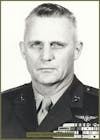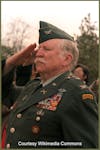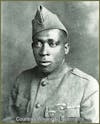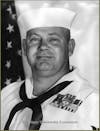US Army Air Forces Col. Bruce Carr: The Remarkable Escape Story during WWII
Colonel Bruce Carr wasn't just a fighter pilot, he was a master of defying odds. This episode dives into the incredible true story of how he evaded capture after being shot down, then stole a German plane to escape. We'll a...
Colonel Bruce Carr wasn't just a fighter pilot, he was a master of defying odds. This episode dives into the incredible true story of how he evaded capture after being shot down, then stole a German plane to escape. We'll also explore his rise to becoming a flying ace in World War II and his continued bravery during the Korean and Vietnam Wars. Get ready for an action-packed journey that will leave you inspired by Colonel Carr's unwavering courage and ingenuity.
Please visit our website to learn more about other American Heroes.
www.dutyandvalor.com
Sources:
wikipedia.org
warhistoryonline.com
findagrave.com
theaviationgeekclub.com
Thank you for listening to Duty & Valor!
Music by Amelie Leclerc. Artist's other music can be found here.
Please follow us on your favorite social media site.
Facebook
Instagram
Twitter
YouTube
Welcome back everyone. On today's episode of Duty & Valor, you’ll hear the story of a man who wanted nothing but to fly for his country during WWII. A man who was known for his aggressive, but effective tactics over the skies of Europe. A man who employed pure cunning while avoiding capture after being shot down. This is the story of the daring escape of US Army Air Forces Pilot Colonel Bruce Carr.
Bruce was born on January 28, 1924 in Union Springs, NY to parents Harry and Eunice Carr. In 1939 when he was just 15 years old, Bruce began taking flying lessons, and when the US entered WWII, he was too young to enlist. By September 1942 was eighteen and enlisted in the US Army Air Forces, entering the Aviation Cadet Training Program. Ironically, the flight instructor there was the same one who trained him to fly when he was 15.
As Bruce had a good amount of flying time under his belt, he was placed into the accelerated training program. At Spence Field, GA he was seated in the P-40 Warhawk and in August 1943 he was promoted to flight officer, which was a rank used by the United States Army Air Forces during WWII equivalent to a warrant officer.
Flight Officer Carr would finally be deployed to Europe in February 1944. There he was assigned to the 380th Fighter Squadron of the Ninth Air Force stationed in England.
On March 8, 1944 in his P-51 named, Angel’s Playmate, Carr jumped into action. In early fighting, Flight Officer Carr chased and shot at a Messerschmitt BF 109. The German fighter pilot flew at a very low altitude in an attempt to avoid the relentless attack by Carr. The German eventually bailed out, sending the fighter plane crashing into the ground. Even though Carr had hit the plane, he wasn’t given credit for the kill. It was deemed that the cause of the crash was not a direct result of his gun fire. When he returned to base, Carr was also reprimanded for being overaggressive in his chase of the German plane.
Two months later in May, he was transferred to the 353rd Fighter Squadron. Flying with his new unit on June 14, he had an unconfirmed kill over Normandy, France. He would go on to get his first confirmed aerial victory three days later when he downed a Focke-Wulf Fw 190. The very next day, his squadron transferred to an airfield in France.
On August 18, he received a commission as a second lieutenant. The following month, on September 12th, Lt. Carr and his flight spotted several Junkers Ju 88 bombers on the ground at a German airfield. They strafed the bombers and continued on their mission. Some time later, 2,000 feet below them, they spotted over 30 Fw 190’s. They engaged the German fighters and Lt. Carr was credited with downing three of them. He may have achieved more aerial victories that day, but he escorted another pilot and his damaged plane away from the fighting and back to their base. His prowess in the air was growing and he would be recognized for his actions that day with a Silver Star.
On November 2, 1944 Lt. Carr took off on a doomed strafing mission over Czechoslovakia, but returned a legend. While over one of his targets, his P-51 was hit by flak, forcing him to bail out. For days he avoided capture, but since he had no food or water, he decided to surrender. The Luftwaffe were known for treating downed airmen better than their Army counterparts, so Lt. Carr made his way to the very same Luftwaffe base he had strafed days before, fully intending to surrender.
He made it to the perimeter of the airfield undetected as night was starting to set in. As he made his slow approach, he noticed two mechanics fueling up an Fw 190. The two men then powered up the plane before shutting it down and walking away. It then struck Lt. Carr that he had one more chance to escape, he was going to steal that plane.
While it was still dark, Lt. Carr climbed aboard the German fighter. Looking around, he realized that this wasn’t going to be an easy theft. The cockpit was set up differently than Allied aircraft and all the gauges were labeled in German, a language he couldn't read. After some time he had a good sense of its layout and what each gauge was telling him. Luckily for him, the plane also had an advanced throttle system that controlled multiple functions, making it the easiest to steal by an enemy pilot.
Once he felt ready, Lt. Carr fired up the plane's engines as the sun was rising. The men at the Luftwaffe airfield knew that no planes were planned to depart so the sound of its engine set off alarms. With no time to spare, Lt. Carr couldn’t taxi to the runway. Rather, he aimed the plane towards the corner of the field and throttled up to gain speed. With the eyes of the enemy upon him, Lt. Carr raced across the field and between two hangars before finally getting airborne.
Now in the air, he had to make the 200 mile journey back to his base. Since he was flying a German plane, his greatest risk was of Allied aircrew assuming he was an enemy pilot. His plan to avoid as much detection as possible, he flew just above the treetops. Carr was later quoted as saying that “that choice wasn’t great, because … every .50 caliber M2 machine gun in existence… had taken shots at me.”
He did make it safely back to his base, but he knew that as soon as a German fighter plane was detected, the ground crews would man their anti-aircraft guns and shoot him out of the sky. As he approached the airfield, he realized that he couldn’t lower the landing gear. He also realized that he didn’t have time to circle the airfield and see if he could fix it. Instead he chose to belly land the plane. He lined up his approach and made a hard landing.
As his plane came to a skidding stop, American soldiers were already racing towards the plane and its presumed German pilot. The men surrounded the plane with guns aimed at the cockpit, yelling at him to surrender. During the confusion, Lt. Carr repeatedly yelled at them that he wasn’t a German, but they either didn’t believe him or couldn’t hear him. It wasn’t until a man appeared and ordered the men to lower their weapons before Lt. Carr could breathe a sigh of relief. That man was George Bickel, the Group Commander, who had recognized who was in the cockpit.
Months later on April 2, 1945, Lt. Carr and three other pilots were on a mission over Germany when 60 enemy fighters were spotted above them. Though they were in a tactically inferior position, and grossly outnumbered, Lt. Carr ordered his flight to attack. During the ensuing air battle, the four pilots were able to shoot down 15 of the German fighters. Lt. Carr was personally credited with downing five of them, and damaging a sixth. With the five aerial victories that day, Lt. Carr became the final "Ace in a Day” in the European Theater of the war. In addition to this distinction, he was also awarded the Distinguished Service Cross for his actions that day.
The following week he was promoted to Captain and continued to add to his combat flying resume, and his two final aerial victories of the war occurred on April 25.
Since Capt. Carr was too young to enlist when the war started, he didn’t have the longest combat flying career, but it was still impressive. In total he flew 172 combat sorties and was credited with 15 aerial victories, several more unconfirmed victories, and numerous ground kills.
After WWII concluded, Carr, who was now a Major, flew the F-80 Shooting Star as a member of the Acrojets, the group that preceded the Thunderbirds. Later he was seated in the F-86 Sabre during the Korean War, flying a total of 57 combat missions, before commanding the 336th Fighter-Interceptor Squadron at Misawa Air Base in Japan.
Promoted to Colonel in November 1968, he then served in the Vietnam War. In just one year there, he flew 286 combat missions in an F-100 Super Sabre. During the war he earned the Legion of Merit and three Distinguished Flying Crosses, and he retired from the Air Force in 1973.
Col. Bruce Carr passed away on April 25, 1998 in Florida and is buried at the Arlington National Cemetery.
Colonel Bruce Carr's story is a testament to unwavering courage and resilience. Shot down, he not only evaded capture, but outsmarted the enemy by commandeering one of their own aircraft. His flying prowess earned him the title of ace, and his dedication to his missions continued through the Korean and Vietnam Wars. Colonel Carr's bravery in the face of immense danger serves as an inspiration to push beyond limits, think creatively in challenging situations, and never give up on accomplishing the seemingly impossible.
Thank you for listening to this episode of Duty & Valor. To read more about this week’s hero, check out the sources used in today's episode in our show notes and at dutyandvalor.com.
If you want to listen to our episodes early, we release new episodes on our YouTube channel of the same name on Fridays at 5pm. Also, on our channel we release daily YouTube shorts that highlight our Nation’s heroes, most of whom haven’t been featured on the show yet.
Be sure to like, follow, and share our episodes and please join us for our next episode, where we'll be sharing the inspiring story of another American hero who served with pride and lived with humility.




















